MENG 471/473 Projects - Fall 2018
In MENG 471/473, students work on independent projects that cover a wide range of topics, from traditional mechanical engineering topics (e.g., mechanical device design, fluid flow, and materials analysis) to interdisciplinary topics at the interface between mechanical engineering and other branches of engineering such as biomedical, chemical, electrical, or environmental engineering. Under the supervision of faculty advisers, students investigate physical phenomena through experimental measurement and/or numerical simulation, and they design and construct functioning prototypes to solve engineering problems. The majority of the faculty advisers come from within the mechanical engineering department, with the remaining advisers distributed across the University (and occasionally outside the University). Funding for projects is generously provided by the Yale SEAS Dean's Office and, in some cases, through the faculty advisers. The students were asked to write the following short summaries two-thirds of the way through the semester, when they still had a few weeks to go on their projects. All projects are represented here, except for those that cannot be publicized due to information of a proprietary nature.
Polymeric Micro Pillars for Low-Impact Dust Particle Cleaning
M. Anwar Akkari
Adviser: Dr. Hadi Izadi
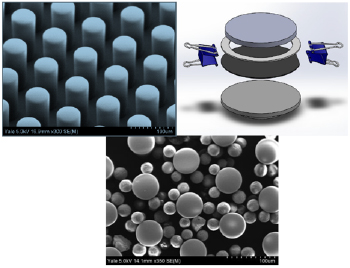 Removal of dust particles from solid surfaces has been the subject of extensive research over the years as scientists seek to develop increasingly efficient and cost effective techniques to address this challenge. Developing such techniques would be useful in various domains such as art conservation and microelectronics. While the elimination of large (>10 μm) particles is simple, existing techniques for removing sub-micrometer particles (particularly < 0.3 μm) are relatively expensive, time-consuming, and more importantly, destructive. Using polymeric pillars with specified geometric properties, an ongoing Yale research project has managed to effectively remove dust particles without damaging surfaces. My work within this project is to design, fabricate and test the setup required to adapt this cleaning technique to remove contamination from semiconductor surfaces. I used 3D rapid prototyping to execute the setup design required for the soft lithography approach that has been used for fabrication of μ-dusters. The setup was then manufactured and tested in terms of reliability and effectiveness. Now, our goal is to develop this prototype to produce a marketable and industrially feasible dust cleaning device that can be used within the semiconductor industry (Silicon and GaAs).
Removal of dust particles from solid surfaces has been the subject of extensive research over the years as scientists seek to develop increasingly efficient and cost effective techniques to address this challenge. Developing such techniques would be useful in various domains such as art conservation and microelectronics. While the elimination of large (>10 μm) particles is simple, existing techniques for removing sub-micrometer particles (particularly < 0.3 μm) are relatively expensive, time-consuming, and more importantly, destructive. Using polymeric pillars with specified geometric properties, an ongoing Yale research project has managed to effectively remove dust particles without damaging surfaces. My work within this project is to design, fabricate and test the setup required to adapt this cleaning technique to remove contamination from semiconductor surfaces. I used 3D rapid prototyping to execute the setup design required for the soft lithography approach that has been used for fabrication of μ-dusters. The setup was then manufactured and tested in terms of reliability and effectiveness. Now, our goal is to develop this prototype to produce a marketable and industrially feasible dust cleaning device that can be used within the semiconductor industry (Silicon and GaAs).
High-throughput Engineered Heart Tissue Culture Bioreactor
Aydin Akyol
Adviser: Prof. Stuart Campbell, Department of Biomedical Engineering
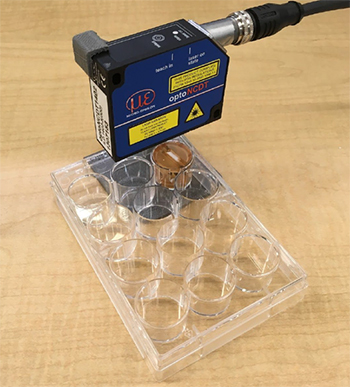 The human heart is an incredibly intricate system of living cells that must continuously operate throughout an individual's life. Like all living cells, cardiac cells (cardiomyocytes) can be impacted by disease or adversely affected by drugs in unexpected ways. To understand and treat disease of these types of cells (cardiomyopathies) as well as prevent adverse effects, the Integrative Cardiac Biomechanics Laboratory (ICBL) studies the dynamics of the heart contraction event. However, there are some challenges to studying living, beating heart tissue, and perhaps the most important is growing and conditioning a suitable engineered heart tissue (an EHT). An EHT starts as undifferentiated stem cells and takes form when seeded onto a decellularized scaffold of heart tissue slices. Afterwards, the EHT is then cultured through a combination of chemical exchange and external, periodic electrical stimulus similar to the pacing of the human heart. After sufficient culturing, the tissue is then used in experiments. Current growth and conditioning systems hold tissues static while providing electrical stimulus, but this has several limitations: the conditioning does not provide any measurements during tissue culture, exposes samples to contamination, and relies on external motion sources to stimulate culture media. We propose an improved system that makes use of optoelectronics to provide force measurement and an autoclavable structure to allow for contraction. Such a device could serve as a chassis for future developments in providing a system for high-throughput growth, conditioning, and measurement thereby empowering engineered tissue culture for potentially life-saving research.
The human heart is an incredibly intricate system of living cells that must continuously operate throughout an individual's life. Like all living cells, cardiac cells (cardiomyocytes) can be impacted by disease or adversely affected by drugs in unexpected ways. To understand and treat disease of these types of cells (cardiomyopathies) as well as prevent adverse effects, the Integrative Cardiac Biomechanics Laboratory (ICBL) studies the dynamics of the heart contraction event. However, there are some challenges to studying living, beating heart tissue, and perhaps the most important is growing and conditioning a suitable engineered heart tissue (an EHT). An EHT starts as undifferentiated stem cells and takes form when seeded onto a decellularized scaffold of heart tissue slices. Afterwards, the EHT is then cultured through a combination of chemical exchange and external, periodic electrical stimulus similar to the pacing of the human heart. After sufficient culturing, the tissue is then used in experiments. Current growth and conditioning systems hold tissues static while providing electrical stimulus, but this has several limitations: the conditioning does not provide any measurements during tissue culture, exposes samples to contamination, and relies on external motion sources to stimulate culture media. We propose an improved system that makes use of optoelectronics to provide force measurement and an autoclavable structure to allow for contraction. Such a device could serve as a chassis for future developments in providing a system for high-throughput growth, conditioning, and measurement thereby empowering engineered tissue culture for potentially life-saving research.
The Effect of Structure on Properties of Bulk Metallic Glass
Aidan Brooks and Madison Sprole
Advisors: Amit Datye and Prof. Udo Schwarz, Department of Mechanical Engineering & Materials Science
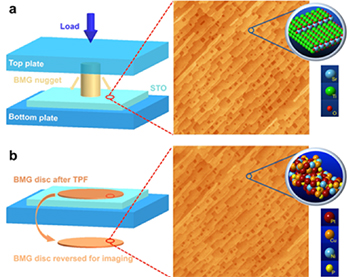 The Yale Nanoprobe Group has investigated the structure of bulk metallic glass to determine whether a certain set of thermoprocessing techniques can be linked unambiguously to specific mechanical characteristics, which can be reproduced in any setting. The Group varied the fictive temperature and annealing time of each sample, and subsequently examined the ordering and the mechanical properties using tensile, compressive, and nanoindentation testing. It was found that lower fictive temperature caused more annihilation of the excess free volumes, and thus higher sample density with the lower free volume; after mechanical testing, it was observed that lower fictive temperature samples corresponded with higher yield and fracture strengths, density, and greater sample hardness. Furthermore, testing revealed a direct linear relationship between free volumes and enthalpy change in the samples, and negative exponential relationships between annealing time and enthalpy change, and between fictive temperature and enthalpy change. Thus, it was concluded that if any of the following quantities were known, the rest could be extrapolated: free volumes, enthalpy change, annealing time, fictive temperature, and mechanical properties. These advances, in bulk metallic glass thermoprocessing techniques, broaden the field of applications for bulk metallic glasses, by allowing for very precise control over mechanical and thermodynamic properties. This precision allows for use in high precision electronics, applications in space exploration technology, and could even be applied to other more conventional glasses.
The Yale Nanoprobe Group has investigated the structure of bulk metallic glass to determine whether a certain set of thermoprocessing techniques can be linked unambiguously to specific mechanical characteristics, which can be reproduced in any setting. The Group varied the fictive temperature and annealing time of each sample, and subsequently examined the ordering and the mechanical properties using tensile, compressive, and nanoindentation testing. It was found that lower fictive temperature caused more annihilation of the excess free volumes, and thus higher sample density with the lower free volume; after mechanical testing, it was observed that lower fictive temperature samples corresponded with higher yield and fracture strengths, density, and greater sample hardness. Furthermore, testing revealed a direct linear relationship between free volumes and enthalpy change in the samples, and negative exponential relationships between annealing time and enthalpy change, and between fictive temperature and enthalpy change. Thus, it was concluded that if any of the following quantities were known, the rest could be extrapolated: free volumes, enthalpy change, annealing time, fictive temperature, and mechanical properties. These advances, in bulk metallic glass thermoprocessing techniques, broaden the field of applications for bulk metallic glasses, by allowing for very precise control over mechanical and thermodynamic properties. This precision allows for use in high precision electronics, applications in space exploration technology, and could even be applied to other more conventional glasses.
Electrical Arc Power Conversion for Atmospheric Arcjet Applications
Kai Dougan and Miles Petterson
Adviser: Prof. Juan de la Mora, Department of Mechanical Engineering & Materials Science
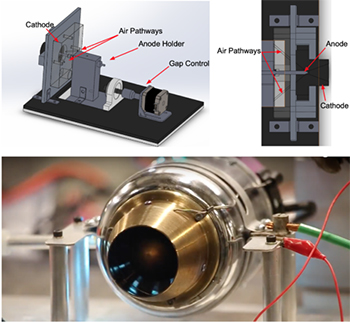 The aviation industry has historically depended on fossil fuels for propulsion. However, recent advances in battery technology have paved the way for competitive electric propulsion technologies. This project seeks to design and build a green alternative to the jet engine, with comparable performance characteristics. By integrating an electrical arc heating system into the thermodynamic cycle of a traditional jet engine, we aim to verify the feasibility of an electrically powered, thermal jet engine. We developed an initial prototype that delivers heat to the gas via a mechanically constricted plasma, instead of by combustion. This plasma power is modulated through real-time control of the arc distance between anode and cathode elements. Current work on this project aims to optimize the heat transfer from the arc to the working fluid. By simulating the operating pressures and mass flow rates of a jet engine combustion chamber, we have initially verified the exhaust temperatures of this scaled system. Preliminary tests revealed significant radiative heat losses at low mass flow rates. Based on this result, we plan to enhance our test apparatus to enable operation at a higher range of pressures and flow rates. As operating conditions change, arc stability needs to be continually adjusted. With a more versatile arc system, we will further quantify the efficiency of energy transfer between the arc plasma and the working fluid within the envelope of our engine’s operating conditions. Building on this understanding, we will further refine our arc system to maximize the performance of our engine.
The aviation industry has historically depended on fossil fuels for propulsion. However, recent advances in battery technology have paved the way for competitive electric propulsion technologies. This project seeks to design and build a green alternative to the jet engine, with comparable performance characteristics. By integrating an electrical arc heating system into the thermodynamic cycle of a traditional jet engine, we aim to verify the feasibility of an electrically powered, thermal jet engine. We developed an initial prototype that delivers heat to the gas via a mechanically constricted plasma, instead of by combustion. This plasma power is modulated through real-time control of the arc distance between anode and cathode elements. Current work on this project aims to optimize the heat transfer from the arc to the working fluid. By simulating the operating pressures and mass flow rates of a jet engine combustion chamber, we have initially verified the exhaust temperatures of this scaled system. Preliminary tests revealed significant radiative heat losses at low mass flow rates. Based on this result, we plan to enhance our test apparatus to enable operation at a higher range of pressures and flow rates. As operating conditions change, arc stability needs to be continually adjusted. With a more versatile arc system, we will further quantify the efficiency of energy transfer between the arc plasma and the working fluid within the envelope of our engine’s operating conditions. Building on this understanding, we will further refine our arc system to maximize the performance of our engine.
Practicing De-escalation: A Mechanical System for Training Police Officers
Alex Galland
Advisors: Dr. Joran Booth and Kevin Ryan, Electrical Engineering
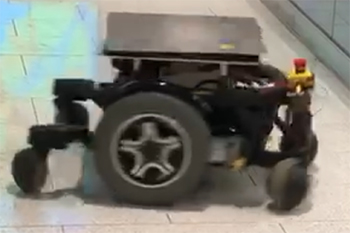 Police brutality has been a hot button issue for many years in America. Countless unfortunate shootings have unfolded before our eyes, endangering the lives of many innocent people and raising serious questions about how police officers are trained. A new emphasis is being placed on “de-escalation” which simply means avoiding violence wherever possible and seeking less lethal alternatives to bringing suspects into custody. However, this is difficult to do in many cases without endangering the officers themselves. So, the challenge being faced is how to go about minimizing the lethal force being used without endangering the lives of the police officers. Currently, the way most officers are trained to use their firearms is they see a target and they shoot it multiple times within an allotment of time. The target doesn’t move, it’s the same size and shape every time, which is simply nothing like a real-world scenario. In the real world, a situation presents itself almost instantly, can change at any moment, and very often does not require a shot to be fired. In this project, I created a remote controlled motorized robot base fabricated from reasonably low-cost materials. I also investigated concepts for presenting targets to officers in training. Some functionalities were achieved while others were left just out of reach. While full functionality was not achieved, the end result was that a proof of concept was generated for this target system.
Police brutality has been a hot button issue for many years in America. Countless unfortunate shootings have unfolded before our eyes, endangering the lives of many innocent people and raising serious questions about how police officers are trained. A new emphasis is being placed on “de-escalation” which simply means avoiding violence wherever possible and seeking less lethal alternatives to bringing suspects into custody. However, this is difficult to do in many cases without endangering the officers themselves. So, the challenge being faced is how to go about minimizing the lethal force being used without endangering the lives of the police officers. Currently, the way most officers are trained to use their firearms is they see a target and they shoot it multiple times within an allotment of time. The target doesn’t move, it’s the same size and shape every time, which is simply nothing like a real-world scenario. In the real world, a situation presents itself almost instantly, can change at any moment, and very often does not require a shot to be fired. In this project, I created a remote controlled motorized robot base fabricated from reasonably low-cost materials. I also investigated concepts for presenting targets to officers in training. Some functionalities were achieved while others were left just out of reach. While full functionality was not achieved, the end result was that a proof of concept was generated for this target system.
The Effect of Mechanical Cycling on the Fracture Toughness of Bulk Metallic Glasses
Derek Kuldinow
Advisor: Prof. Jan Schroers, Department of Mechanical Engineering & Materials Science
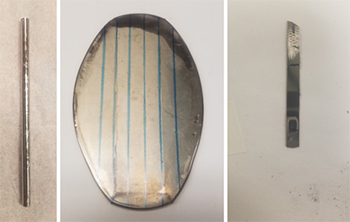 The amorphous structure of Bulk Metallic Glasses means that instead of packing atoms optimally, they often have an amount of ‘free space’ which affects their mechanical properties. The particular property we are interested in is fracture toughness, which is a measure of how materials resist growth of cracks and imperfections. It has long been known that repeatedly applying stress to a BMG can reduce its fracture toughness, a form of fatigue known as relaxation; however, it has recently been shown that in certain stress range, repeated cycling can actually increase fracture toughness. To quantify these effects, we use Thermoplastic Forming to create samples out of Pd 43 Cu 27 Ni 10 P 20 alloy stock BMG. We then cycle each of these samples ten times to 70, 80 or 90 percent of their yield stress, cut a notch and then stress it until failure. From this, we can calculate the change in fracture toughness of each sample. By the end of the semester, we hope to have at least 4 data points for each stress level to determine if further study into number of cycles, cycle stress or loading axis are worthwhile and if this method might be viable to increase industry-made BMG samples.
The amorphous structure of Bulk Metallic Glasses means that instead of packing atoms optimally, they often have an amount of ‘free space’ which affects their mechanical properties. The particular property we are interested in is fracture toughness, which is a measure of how materials resist growth of cracks and imperfections. It has long been known that repeatedly applying stress to a BMG can reduce its fracture toughness, a form of fatigue known as relaxation; however, it has recently been shown that in certain stress range, repeated cycling can actually increase fracture toughness. To quantify these effects, we use Thermoplastic Forming to create samples out of Pd 43 Cu 27 Ni 10 P 20 alloy stock BMG. We then cycle each of these samples ten times to 70, 80 or 90 percent of their yield stress, cut a notch and then stress it until failure. From this, we can calculate the change in fracture toughness of each sample. By the end of the semester, we hope to have at least 4 data points for each stress level to determine if further study into number of cycles, cycle stress or loading axis are worthwhile and if this method might be viable to increase industry-made BMG samples.

